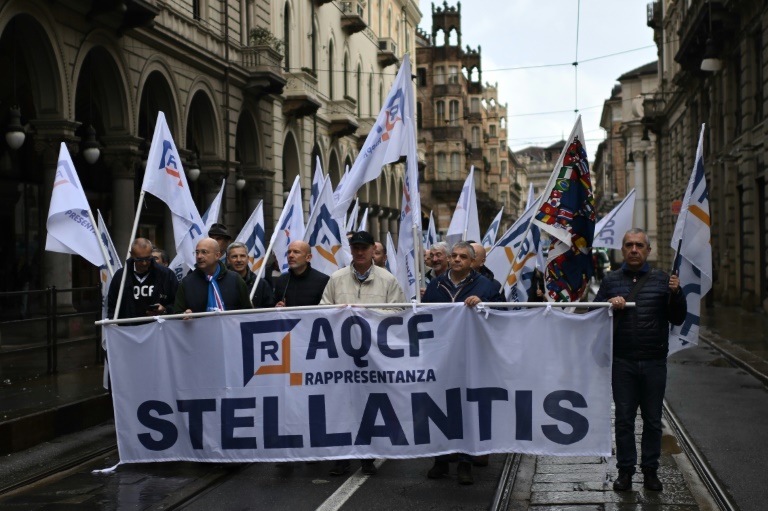On a significant day for labor rights in Italy, thousands of Stellantis workers across the country took to the streets to voice their frustrations regarding temporary layoffs and ongoing production stoppages. Unions, representing the company’s 40,000 employees, coordinated a 24-hour national strike, urging for job security and the introduction of new models to revitalize the troubled Italian auto industry. Demonstrations were primarily concentrated in Rome, with approximately 20,000 participants, while another 300 gathered in Turin. Union leaders described the strike as unprecedented in scale, noting that it was a landmark event not seen in Italy for over 40 years. This mobilization reflects the dire circumstances workers face in an industry already burdened by economic challenges.
Stellantis, the merged entity of Fiat, Chrysler, and Peugeot-Citroen (PSA) formed in 2021, has been grappling with adverse market conditions following a promising growth period. Workers have witnessed a sharp decline in production, which plummeted by 31.7 percent during the first three quarters of 2024, with the figure recorded at just 387,600 vehicles—the lowest output in nearly seven decades. Predictions loom that Stellantis might produce under 500,000 vehicles for the entire year, a stark contrast to the over 751,000 units manufactured in 2023. The metallurgical union FIM-CISL has raised concerns about falling demand, especially for electric vehicles, stating that the company’s decrease in vehicle output signals a critical downturn in the Italian automotive sector.
Protesters, like Giuseppe Carbonara from Bari, revealed stark personal impacts from the downturn, indicating their work weeks have condensed to just two or three active days, underscoring the volatility of employment in the auto sector. Carbonara’s voice conveys a broader discontent: “There is no industrial policy in Italy.” The sentiment reflects a widespread demand among the workforce for intervention from the government, with calls for collaborative discussions between officials and Stellantis to devise a strategy for economic recovery. Relationships have soured between the company and the Italian government due to the rise in temporary layoffs, further intensifying the urgency for concrete solutions.
Stellantis’s CEO Carlos Tavares announced an ambitious target in July 2023, pledging to uplift vehicle production in Italy to one million units by 2030. However, with the prevailing circumstances, the fulfillment of this goal appears increasingly unlikely. The auto market has experienced stagnation in electric vehicle sales across Europe since late 2023, predominantly attributed to a scarcity of affordable options for consumers. Stellantis cites the Italian government’s delay in rolling out electric vehicle purchase incentives as a significant hindrance to revitalizing their production lines. Moreover, with the impending ban by Brussels on new combustion-engine car sales proposed for 2035, companies face escalating pressure to pivot towards electric models, delivering an additional layer of complexity to the industry.
Just days prior to the strike, Stellantis disclosed plans to halt production in multiple Italian factories again during November to mitigate excess production due to reduced electric vehicle orders. Notably, the production of the electric Fiat 500 at the historic Mirafiori plant has been suspended since mid-September until early November. Other key facilities like Pomigliano d’Arco, Termoli, and Pratola Serra are also slated to experience stoppages, reflecting a broader trend of cutbacks across Stellantis’s Italian operations. The impacts of these factory slowdowns reveal a grim picture of the conditions that once symbolized Fiat’s golden era, underlining the fragile state of the Italian automobile industry.
The sentiments of labor leaders resonate profoundly within the context of the strike. Maurizio Oreggia, an automotive coordinator for the Fiom-Cgil union, painted a bleak portrait of Mirafiori, labeling it a site that is “slowly dying” as production issues persist. The practice of temporary layoffs—utilized to cope with economic strain—has left workers with reduced wages and uncertainty regarding their livelihoods. Rocco Palombella, head of the UILM union, reinforced the urgent tone of the protests, declaring, “Time’s up,” and cautioning that the extinction of the automobile industry could precipitate a severe social crisis across Italy.
The stakes are high as Stellantis and its workforce navigate a precarious path fraught with economic uncertainty and industry shifts. The strike serves not only as a protest of current conditions but as a call to action for both corporate and governmental entities to address the looming challenges head-on. As unions rally together, their demands symbolize a crucial juncture for Italy’s automobile sector, highlighting the urgency for sustainable solutions amidst a deeply transforming automotive landscape. Whether Stellantis will heed these calls or continue grappling with its production hurdles remains to be seen, but the implications of their choices will extend far beyond the walls of the factories, affecting the broader socio-economic frameworks of the region and its workers.

